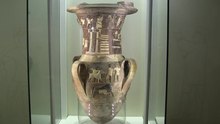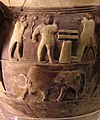Relief vases by Hüseyindede
The relief vases from Hüseyindede were found during excavations at Hüseyindede Tepesi near the village of Yörüklü in the Turkish province of Çorum . The remains of four Hittite vases came to light. Two of them were almost complete and could be restored. They are exhibited in the Çorum Archaeological Museum .
exploration
During site inspections by the Turkish archaeologists Tunç Sipahi and Tayfun Yıldırım in 1996, fragments of Hittite vessels were found on the surface of the southern spur of the Hüseyindede Tepesi mountain. During an emergency excavation in 1997 and other regular excavations from 1998 in collaboration with the Museum in Çorum, fragments of clay jugs and parts of four different ancient Ethite relief vases came to light. Two of them were found in a storage room of an excavated building, the other two under the surrounding rubble. They have been restored in the museum. The smaller vase B, which has a surrounding picture frieze, was published by Sipahi in 2000, while the restoration of the second, known as vase A, which has four friezes, was still in progress. It was finally presented by Yıldırım at the Hittite Congress in Ankara in 2002.
Relief vases
Vases with relief friezes have been known from the ancient Ethite times since the excavations of Boğazköy , the capital of Hattuša . Fragments are also known from Alişar , Alaca Höyük , Eskiyapar , Kabaklı, Elbistan-Karahöyük and Kaman-Kalehöyük . They are generally used in the early days of the Hittite Empire, in the first quarter of the 2nd millennium BC. Dated. The only reconstructable examples are a four- frieze vase from İnandıktepe , which can be seen in the Museum of Anatolian Civilizations in Ankara , and a fragment from Bitik showing three friezes . What they all have in common are the depicted motifs, ritual acts, sacrificial scenes and festivities with acrobats, dancers and musicians and is therefore an important visual testimony to Hittite music and religion .
description
Gold mica is added to the clay of the vases, which is typical of ancient Ethite ceramics. They are created on the potter's wheel. After completing the vase, the figures were made from higher quality clay and glued to the frieze surface. This was notched for better adhesion. The colors used are red, black and cream.
From a vase of the Bitik-İnandık type, i.e. with four rows of pictures, three parts have been preserved, which show a male figure, probably a cook, and two-handled saucepans, as they were from the time of the Assyrian trading colonies ( Karum period) and from Hittite times are known. A deity, a lion and other figures are depicted on the fragments of a second vase of the same type. The two restored vessels are called Vase A and Vase B.
Vase A.
Vase A is of the type mentioned with four rows of figures. It has four handles with a height of 86 and a diameter of 50 centimeters. These appear to have been the standard dimensions for vases of this type. A tube runs around the upper edge, interrupted by a basin and four bull's head protomes . In the course of sacrificial ceremonies, liquid could be poured into the basin, which flowed through the bull's mouths into the interior of the vessel. This device is also typical of the Bitik-İnandık vase type, it is already known from Rhyta from Kültepe .
The two lower picture strips are separated into four scenes by the handles. The bottom row shows four bulls alternately facing left and right with their heads bowed to attack. They are usually assigned to the local weather god. Their dynamic posture is unique in the Hittite iconography of the time, in contrast to other depictions where they are led or prepared for sacrifice. They form a supporting basis for the overlying scenes, as is known, for example, from seal impressions, from a bronze plate from Alaca Höyük or an ivory plate from Megiddo . The four scenes in the second row show a procession of sacrifices walking towards a god. In the first three pictures, a roebuck, then a stag and a ram are probably shown. The deer and stag are each led by a male person with a short skirt on a rope, the ram by a man walking sideways. In front of it, two other men, probably priests, can be seen in a prayer position. In the fourth scene on the right the god is depicted on a chair with a backrest, in front of it another adorant and a musician with a lyre . A similar scene can be seen on İnandık's vase, but there the adored weather god symbolized by a bull is very similar to the relief of the othostat row by Alaca Höyük.
The third frieze, the widest and best worked out, again depicts a procession moving towards a temple and an altar. The clay bricks of the temple building are shown in different colors. Objects on the roof can possibly be interpreted as altars; Yıldırım suggests decorative objects or a railing as an alternative. To the right of the temple there is an altar which again reminds of the orthostats of Alaca Höyük. Several people approach the building from the left. The rearmost one is a musician who plays a plucked instrument similar to the Turkish saz . A woman walks in front of him holding a pair of cymbals . In front of it are three women with cult objects in their hands. The objects on the left cannot be interpreted; Yıldırım regards the one in front as a portable metal brazier, as mentioned in Hittite texts in connection with religious acts. The procession is led by two male sword-bearers. The last scene in the third frieze on the right of the altar is remarkable. Two female figures are shown sitting opposite one another on a bed and a man standing next to them who is holding up a bowl. The woman on the right seems to help the other with decorating or making up. The one on the left, dressed in black, probably represents a goddess or queen. One possible interpretation mentioned would be a connection with a holy wedding . Then the standing person would be the bridegroom, king or God. So far, one can only speculate about the identity of the portrayed because of the lack of defining attributes. According to another reading, the figure on the left would be a sculpture, as would another figure sitting on a cart in the top frieze. In texts it is reported that statues in temples were adorned on ceremonial occasions and carried along in processions.
A few fragments are missing from the fourth, uppermost frieze of the vase, which again shows a procession. You can see an ox cart with two people, a priest and a goddess - or the sculpture mentioned above - being transported on the rear loading area. The middle part of the car, on which cult objects are probably hidden under a tarpaulin, is missing. On the right you can see the head of the draft animal with the horns and the drawbar held by a leading man. The other figures in this series represent musicians, two men who play the lute, a woman with a pair of cymbals and a dancer. A male figure with a quiver-like structure on his back is incomplete.
Vase B.
With a height of 52 centimeters, the handleless vase B is smaller and has only one frieze around the neck. Since parts of the already destroyed vase were affected by fire, their colors have changed. The originally red and cream-colored painting has taken on darker browns, reds and blacks. Only one fragment of the frieze, a woman with a basin, has the original colors. The image strip extends under the sweeping edge with a height of 7 to 7.5 centimeters and a circumference of 52 centimeters around the vessel. Its main theme is an acrobatic scene, which is accompanied by musicians and dancers.
According to the usual opinion, two women portrayed frontally are to be seen as the left beginning of the overall scene. They wear long, sweeping robes decorated around the hips and hold hands. Sipahi interprets them as dancers who perform a round dance, comparable to today widespread in eastern Turkey Halay . They are followed by a woman and a man who play cymbals. This instrument, which Hans Gustav Güterbock , among others, equates with the galgaturi from Hittite texts, is a frequent motif in Hittite visual art and especially on relief vases. It is unusual that both women and men hit the pelvis here. The next figure is a male musician with a long-necked lute. This instrument, known today as the Saz, also appears frequently on the well-known Old Ethite vases. The following two incomplete male figures hold pelvis in their hands and are depicted in a crouched position. From the position of the legs it can be concluded that they are in a dance movement. After another standing cymbal player, of whom only part of the head and the hands with the cymbals have survived, the main scene of this frieze follows.
This central scene shows three acrobats jumping over a bull. The bull stands facing to the right and is held by a halter by a single man. He holds an object in his right hand, possibly setting the pace for the performances. Only the arms and head of the bull jumper on the left have survived. By comparison with the corresponding pictures on vases from İnandık and Boğazköy, it can be assumed that it is shown at the moment of the jump. A second man can be seen doing a backflip, pushing one foot off the animal's rear end. The third artist builds a bridge on the bull's back. Since the positions of the three jumpers are very different, it can be ruled out that there are three phases of a jump. Rather, simultaneous actions are shown in which artists or dancers perform their performances on and around a quietly standing bull. This is where the ancient Ethite depiction differs from the Minoan bull leaping motifs, which are mainly known from Knossos . In contrast to the more sporty exercises in the Aegean culture, in which the animal was jumped over from the front or the side at full speed, one sees here a ritual performance on and next to a calmly standing bull.
literature
- Tayfun Yıldırım: Yörüklü / Hüseyindede. A new Hittite settlement in the southwest of Çorum. In: Istanbuler Mitteilungen 50, 2001, pp. 43–62.
- Tunç Sipahi: An ancient Ethite relief vase from Hüseyindede Tepesi. In: Istanbuler Mitteilungen 50, 2001, pp. 63–85.
- Tunç Sipahi: New Evidence from Anatolia Regarding Bull-Leaping Scenes in the Art of the Aegean and the Near East. In: Anatolica 27, 2001, pp. 107-125.
- Piotr Taracha : Bull-lepaing on a Hittite vase. New light on Anatolian and Minoan religion. In: Archeologia (Warszawa) 53, 2002, pp. 7-20.
- Tayfun Yıldırım: Music in Hüseyindede / Yörüklü: Some New Musical Scenes on the Second Hittite Relief Vase In: Anadolu Araştırmaları / Yearbook for Asia Minor Research 16, 2002, pp. 591–600 PDF .
- Tayfun Yıldırım: New scenes on the second relief vase from Hüseyindede In: Studi micenei ed egeo anatolici Volume 5, 2008 pp. 837–850









